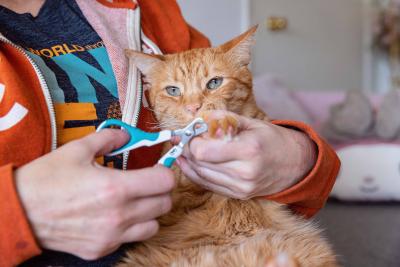You (yes, you) are a cat trainer

At Best Friends, it kind of goes without saying that we love cats. (Heck, we love all animals.) So when it comes to experts in all things feline, we make it a priority to surround ourselves with the best of the best. And that’s who Samantha Bell is: the crème de la crème of cat care.
Samantha, Best Friends’ cat expert, has been training cats for more than a decade, both in shelters and in homes. Her passion (above and beyond cats, cats, and more cats) is sharing her knowledge of feline behavior with people like you so that you and your cats can cohabitate in a state of blissful unity.
Here’s what Samantha has to say about why she believes that anyone who has ever interacted with a fuzzy purr-ball is, in fact, a cat trainer.
We are all cat trainers. There, I said it. You may insist that you’re only the provider of lap real estate for your fickle felines — or simply the one who doles out the daily kibble. But before you prepare to debate further, hear me out.
Here’s the thing: All day long, our cats do adorable things that we want to see more of. Conversely, we’d like to see them do other things less often. You have the power to make both things happen. Yes, you.
Best of all, you have the power to instill these behaviors without learning complicated training techniques, spending an exorbitant amount of time, or carrying around pockets full of treats. Training your cats is simpler than that. It’s just a matter of reframing how you interact with your pets — because every interaction we have with our cats is an opportunity to train them.

Why train a cat?
It may seem silly to invest in training our kitty friends. However, there’s a host of reasons why training our cats pays off in dividends. For one, training strengthens the bond we have with our cats. It also improves their sense of well-being and enriches their lives — and our lives — overall.
No, we don’t need our cats to perform fancy tricks, but we do need them to thrive within the parameters of the human world. And being aware of how we interact with them is an important step toward achieving this goal. Training a cat is not difficult (which is why you probably had no idea you were already doing it).
When your cats do something adorable, do you ever praise them for how cute it was, using your “cat voice”? If so, perhaps without even intending to, you’ve encouraged them to do that thing more often. But what about those times when they do something you don’t want them to do? Do you ever say the cat’s name and tell them to stop? In doing so, believe it or not, you’ve actually trained your cat to repeat that unwanted behavior. Yes, it’s true: We often accidentally reward our cats when they do something we don’t like.
Years before I became a cat behavior expert, my cat Yohan enjoyed hanging out on the kitchen counter while I prepared food for my three kitties. I didn’t want Yohan up there because counter space was limited, and he ate the food before I had a chance to set it out for all the cats.
But Yohan was very sensitive and connected to me, and I didn’t want to upset him. So when he was on the counter, I’d gently say in my high-pitched cat voice: “Oh, my sweet baby Yohan. Mama doesn’t want you up here right now.” Then I’d tenderly pick him up, kiss him on the head, and put him on the floor.

Let’s look at that exchange a bit closer from Yohan’s perspective. Yohan loves it when I say his name. (Check.) Yohan loves baby talk. (Check.) Yohan loves kisses on the head. (Check.) What had I done? I’d inadvertently trained Yohan to get on the counter at the exact time I didn’t want him to be there. He had a behavior I did not want to see repeated, and yet my response only encouraged him to continue that behavior.
So if your cat is doing something you don’t like, make sure you aren’t actually implying that you want them to do more of it. Even yelling at your cat (which I do not suggest) can be seen as a reward to a friendly cat because it’s a form of attention. Since Yohan loves hearing his name, if I exclaim “Yohaaan!” out of exasperation when he’s doing something I don’t want him to do, I’ve just rewarded him. The tone is irrelevant to him. Quite likely, he will exhibit the behavior again to get the extra attention.
[Cat Behavior Modification and Counter-Conditioning]
Here’s a better approach: First, consider why your cat is doing it. Was Yohan getting on the counter because he was hungry? Because he wanted to be close to me? Because he liked to be up high? Because he could have easier access to the food? Consider all the angles, and try to solve the various potential issues. In our case, I realized that Yohan always deferred to the other cats and would let them eat first. One reason that he jumped up on the counter was to get stress-free, first-in-line access to his food. Another reason appeared to be that he loved the one-on-one time I couldn’t help but give him while he was up there.
My solution was two-fold. First, I changed how I fed the cats. Instead of them all having their food stations in the living room, I moved Yohan’s to his own special area. I set down the other cats’ food first, and then, while they were busy eating, I put Yohan’s bowl in the hallway.
Second, I stopped fawning over him when he was on the counter. I’d pick him up silently and gently set him on the floor. Next, I’d lovingly say his name and give him the attention he was seeking. He now has no need to jump on the counter because I provide him with a less stressful option for eating and I give him the demonstrations of love he craves when he’s not on the counter.

The power of positive reinforcement
With any cat behaviors that aren’t ideal, the goal is to figure out exactly what your cats want, give that to them in ways that work for you, and then reward them for embracing this new approach. This type of positive reinforcement can correct a variety of unwanted behaviors. Is your cat scratching in a place, such as your sofa, where you’d rather they did not? Don’t say their name or interact with them when they do because they might interpret it as a reward. Instead, lure them away from the sofa and encourage them to scratch on appropriate objects, and then (this is key) reward them when they do that.
If your cat is chewing on things that they shouldn’t chew on, what should you do? For starters, don’t say their name or provide any surplus attention for the behavior. Instead, find appropriate items for them to chew on, such as cardboard boxes, cat grass, and fake plants. Introduce these alternatives to your cat, and then praise them when they chew on them.
Most of the behaviors that people see as negative in their cats — like climbing, chewing, and scratching on things — are actually just instinctive feline behaviors. Because it’s never OK to extinguish an animal’s instinctive behavior, we need to find appropriate outlets for these behaviors and reward our cats for doing it “our way.” It’s a balance between providing them with the tools to thrive in our world while satisfying the needs that come instinctively in theirs.
Yohan’s story is an example of how to change unwanted behavior. Here’s an example of how to encourage behavior we want to see more of: My cat Desmond was never a lap cat, but I always wished he would be. Recently, he started jumping on my lap in the evening, which I want him to do more often.
So while he’s there, I say his name sweetly and pet the sides of his cheeks — his favorite things. I turn down the TV volume and make life for him as comfortable as possible while he’s hanging out with me, so he’ll do it more often. I’m happy to say that this technique has worked. Desmond is now a lap cat.
One way for me to keep it that way is by avoiding activities Desmond doesn’t find pleasurable when he’s in my lap. If I notice he needs a bit of crust cleaned out of an eye, I refrain from touching the area because I know he doesn’t like it. In avoiding this task at that moment, I am encouraging future lap time.
The same goes for nail trims. I typically realize that Desmond needs his nails trimmed when he’s in my lap, but that’s the exact time I should not be trimming his nails. If I want lap time to continue, I need to make sure the entire experience is rewarding.

I tackle tasks like nail trims while my cats are lying around or sleeping because they’re in a calm, neutral state. Some days, I only get a couple of nails trimmed before Yohan gets annoyed, and that’s OK. I always stop before the interaction becomes unpleasant, and then I reward my cats with a high-value treat immediately after. They’ve learned that nail trims don’t have to be unpleasant, which ultimately makes life easier for all of us.
Our cats are constantly learning from their interactions with us humans. By simply paying attention to how we respond to them, we can train them to live with us in a way that makes everyone happy. Just ask Yohan and Desmond. Now, go forward, you cat trainer. You’ve got this.
This article was originally published in the May/June 2023 issue of Best Friends magazine. Want more good news? Become a member and get stories like this six times a year.
Cats rule
Learn more cat training tips, resources, and information from Samantha.
Read more
Cat’s transformation from scary to sweet
